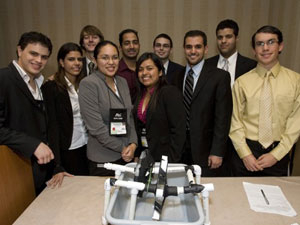Cullen College student takes home first place in rigorous round-the-clock competition
Rehan Momin, a senior electrical engineering major, was among a group of students last month to win an intense 24-hour competition centered on designing a water supply system for use in an impoverished Latin American country.
Held at the Society of Hispanic Professional Engineers national conference for the last three years, the competition is dubbed the “Extreme Engineering Challenge.”
In the round-the-clock exercise testing patience and problem solving, Momin and his team were pitted against seven other student teams. All were tasked with creating an imaginary company, physically designing a water supply system meeting specifications set by a made-up client and presenting their final design to buyers.
“At one point I calculated it; I was up 42 hours straight by the end of the competition,” said Momin, who shared the first place title and a $4,000 prize with nine other students from universities across the United States. “But it was worth it. I learned a lot about teamwork, and working with people you haven’t worked with before.”
To earn a ticket to participate in the competition, Momin and other undergraduate and graduate participants had to make an impression on sponsors that included Ford, Intel, Dow Chemical and Chevron, tasked with interviewing close to 160 students prior to their naming 80 to spots on eight teams.
In the Phoenix, Ariz. Convention Center, teams of 10 created companies, named them and set out to design a unique, green-inspired water supply system.
Momin’s team, which included students from Penn State University, Stanford University, the University of California, Berkeley and The State University of New York, used both provided materials and those collected in a $20 shopping spree at a home improvement store to craft a wheel-based water supply system. Following competition guidelines calling for a “green” design the wheel delivered fresh water by aluminum pipe, created from recycled cans. The team also coordinated the use of spinning playground equipment to help power the design.
“I was in charge of materials for the team,” Momin said. “I made sure we were sticking with the green specifications and the materials we were using fit, because if our design didn’t fit the location and the need, then we already failed.”
Sam Attaquile, who developed and has since coordinated the competition, said the challenge is intended to develop and promote students’ engineering skills by simulating an accelerated scenario with deadlines, presentations, reviews and obstacles.
“It’s really a microcosm of what’s going to happen in the workforce,” said Attaquile. “We bring in a lot of uncontrolled obstacles and require you to find your spot. It’s really a 24-hour crash course in what you will see once you graduate.”
